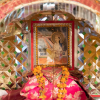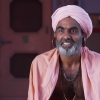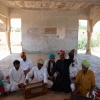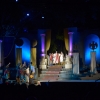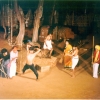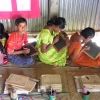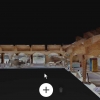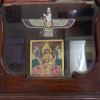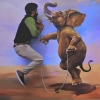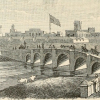My name is Vasant Rathva. I am a resident of Tejgadh. I have studied M.A. in Sociology and I did post-graduate diploma in Tribal Studies course. Now I work in Adivasi Academy. Back in 2000, when I joined Adivasi Academy, 15 students came together to do a post graduate diploma in Tribal Studies. During the study, I spent a lot of time with the founder of our institute, Dr Ganesh Devy and learnt a lot from him. We all were Adivasis but we did not have any ‘Adivasiness’ in us. Nobody had any special knowledge about that. Thanks to Sir (Dr Ganesh Devy), we had several experiences. Based on those experiences, he motivated us to read various books, articles in papers. Reputed professors came from universities like JNU and Bombay University to educate us on Adivasis. In the beginning we believed that Adivasis, among us all were mostly Rathva. After those lectures, the concept of ‘Adivasiness’, became clear. After studying and working with sir, our knowledge improved. We realized that there are many other Adivasi like us in India and also in Gujarat. We should meet them and understand their questions as well. So in the beginning when Sir selected this place for Adivasi Academy, there was no building, house, nothing. It was like a jungle area. Near the entrance, you would see there is a Mahua (Tree); it is a very old Mahua. Under this Mahua tree, our studies and discussions took place. Under that Mahua tree, Mahashweta Devi, and other important people have spoken to us, discussed with us. Several good initiatives, we have started from under that Mahua. Devy sir explained to us that it is a new type of education especially in adivasi society and rural areas. When students run away from education, it is then that we will do some creative work. And through this creative work, we have to find out how to make a living and also stay connected with society. Importantly, adivasi art, literature, education, economic development, how do they all walk together, meaning traditional and modern, how to balance them together. This, Devy sahib taught us very well. This was his main aim, to find an alternative to the education system of India. Before Tejgadh, he looked at various places in Naswadi, and in other areas of Chhota Udepur, for the establishment of the Academy. But he found Tejgadh most suitable. I feel that there must have been some attraction towards us, which is why he chose this place.
During studies, we had the opportunity to interview many Adivasi from different areas. During these interviews, our ideas about Adivasi became very clear. After that we decided what should be done? We all got together and discussed. We had to decide on the objectives to work with the adivasi society? So we decided on five objectives. One was freedom from debt, second was freedom from diseases, third was freedom from migration, fourth was freedom from illiteracy, and fifth was freedom from hunger. We distributed our work, some went into health, some into art and culture, some in economics, and like this we chose various objectives. I felt that the objective of freedom from illiteracy is associated with education and I wished to work on this. I started working on education in Adivasi society. The area of education is very vast and there are problems associated with it like migration, hunger, employment, health. Once there is education, I assumed everything they will go away. That is why I joined Adivasi Education.
In 2002, we were working on education in villages and started around 12 non-formal schools. While working with these non-formal schools, we felt that children whose families migrate, we should set up a residential school, where they can stay and study. Reason for that was a lot of Adivasis in large scale, used to migrate to cities—to Rajpipla, Baroda, and Ahmadabad to work as labors or to do farming. In this situation, children also go with them and they remain deprived of education. In 2005-06 we decided that for these migratory adivasi and their children, we should talk to their parents, discuss with them and bring them to Tejgadh and talk to them about way of life and education. This was very successful; reason was several of adivasi who migrated they left their children here with us in Tejgadh. Based on this model, we started it in the villages as well, similar centers like our Vasant Shala. The specialty of the concept of Vasant Shala is including culture with education. There has never been an attempt to homogenize Indian culture in our education system. Amongst Adivasis the diversity is very high within the society, the lifestyle, familial feelings and structure of society. So how to include this diversity with our modernity, this was our concept.
When we select children for Vasant Shala, we select specially from Naswadi and Kawant which are considered very backward talukas, because there is no provision for employment. The intensity of migration is very high from these areas. We communicate with them in these areas. Those people who migrate, we communicate with such parents (vaaliyo). Our priority is to look for illiterate or drop out children and bring them to Tejgadh. Since 2005-06, 353 students have passed out from Vasant Shala and this year there are 60 children. We have worked on this as an experiment, but our main work which is working similarly in villages we have educated 20, 813 children till now. All these children, today in the various villages are completing their higher education. In the last three years we have converted the Vasant Shala residential school into a multi-lingual institute. In the school, there are children who speak various languages, especially Rathvi, Dungra Bhilli, Dhangi, Tadvi, etc. In our experience the children who study in a multi-lingual system gets more education, and strength to think, the intellectual strength thrives a lot.
If we specifically talk about multi-lingual institutions in India, in Andhra Pradesh and Karnataka experiments with such institutes have taken place. As far as I know, in Gujarat there is no such provision for multi-lingual education. In our governmental system, there is a provision to accommodate two to three languages. But in places where more than three languages are spoken, there is no governmental recognition in the curriculum. So, with adivasi children we begin our work with multi-lingual system, the syllabus or the methods to teach, we do not create a course. When children come in we teachers try to learn from them. What does the child say? What are the feelings of the child? This is the learning attempt. The teacher also learns their language. Then the teacher decides whether to teach her in Rathvi, Gujarati, Dehwali, or in Dungra Bhilli. We have made various books, which we keep in our syllabus, especially the textbooks of Gujarat Government, we have converted them, translated them into Adivasi languages. Especially for children, the words that there are ... like how formally there is ABCD …we create our own pattern and sequence. Among Adivasis which words are spoken most, which words are used in the beginning, like ‘ma’—they come first. So this is how we teach them words. Specifically, we learn the Adivasi language but together with it learn Gujarati, Hindi, English and if there are visitors from other states in the organization, then they also may be taught Kannada, Bengali or Marathi.
We keep the Adivasi drop out children here for two years. During these two years, let us assume a child is of 10 years, so he should have education equivalent to 5th standard. We try in these two years, to bring him at par to the education equivalence of 5th standard and after that send them to formal school. We specially admit children in residential schools, so that they do not drop out again. We have also organized workshops on a large scale in different states of India like Maharashtra, Madhya Pradesh, Rajasthan which have Adivasi populations for organizations working, with their education. The workshop was for five days. We have been doing this work for last 15 years in Adivasi areas, especially in education. Several children who have been educated through us we still maintain contact with them, what is the child doing now? In which trade is he going? If I give you an example, a student who studied here Deepika Rathva she has passed her 12th in Science and has taken admission in the course run in Academy on Health. Similarly, there are several students, who do diploma courses and get jobs in Baroda in IT. Other students are studying science, doing B.Sc.
If someone asks me to share something special about my 15 years here, I will share one thing about Devy Sahib. The stage in which we joined this Adivasi organization in Academy, we had no skills to work, to talk, to write or to travel in other states. He used to orient us, sitting outside on stones, when there was no space here. We usually used to come without eating, so he used to bring chana. Still we continue eating chana during our orientation. Chana was important, to keep us awake and alert throughout the night.
Another special experience was in Delhi, there was a workshop on working with DNT (De-Notified Tribals) and Adivasi. For it some five friends from Tejgadh went to Delhi. When we were going to Delhi, we had an accident of the car and the front end was damaged. But we travelled in the same car and went to Delhi. When we reached Delhi at night, Devy Sir came around 12:00 pm and saw the car, that it was damaged. He did not ask anyone what happened just asked us to shift from one room to the other and noticed whether we had any physical difficulty while shifting things. So the way Sir sees things, his vision very simple and different. The talk about alternative, be it about development or literature, he has put forth with this same vision. When we work in villages, I have had one more special experience. A village at the very corner of Narmada river is Ambadungar and east to Amdadungar is Munuja. There are no facilities till now, for education or any other kind, no scheme has been implemented in that village. I have always gone there for our organizational work with Doctor saheb (Dr Aravind Pratap, Resident Deputy Director, Adivasi Academy) for health camp and education. So when we work there, we stay there all day and night. There we see, emotions of people running high, we can understand their aspirations and disappointments, that nobody has come to our village to work like this. So they stay awake all night with us. We have tried to awaken the hope of Adivasi society and now people are also much aware.



